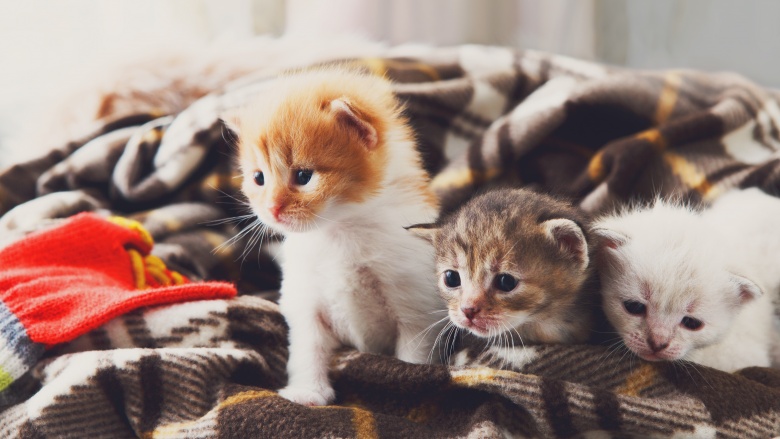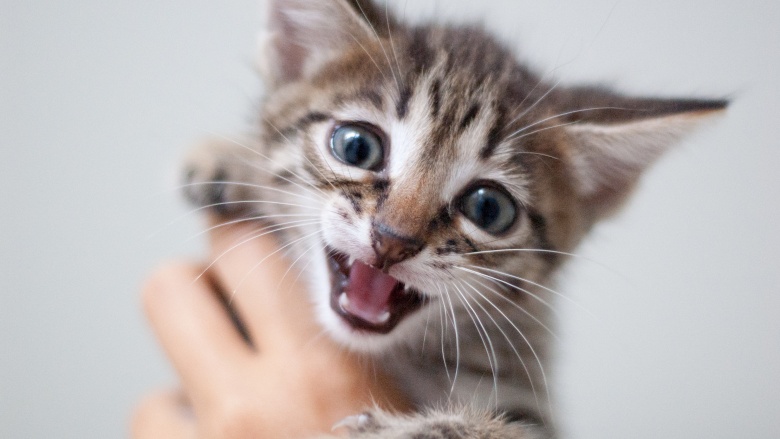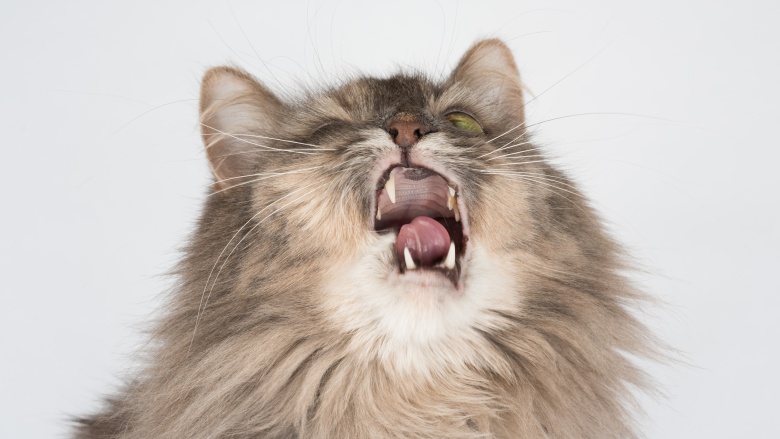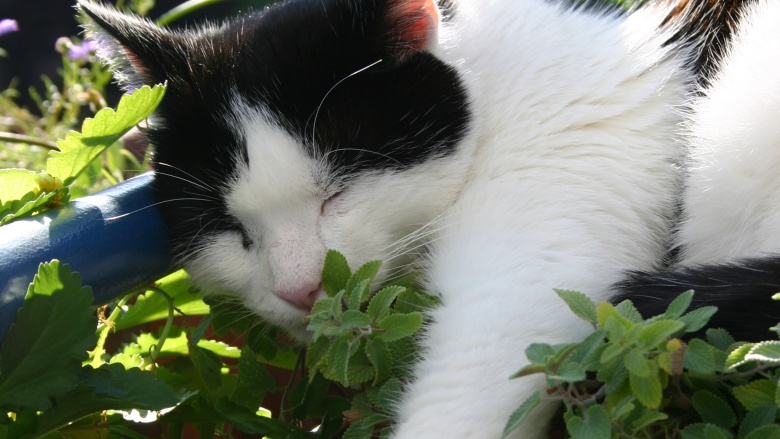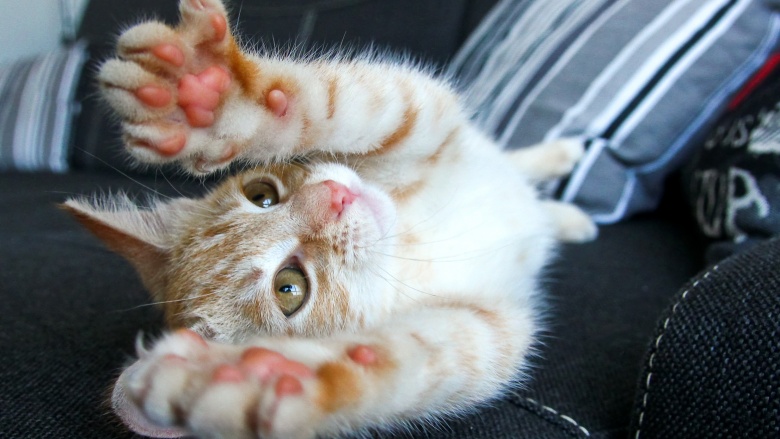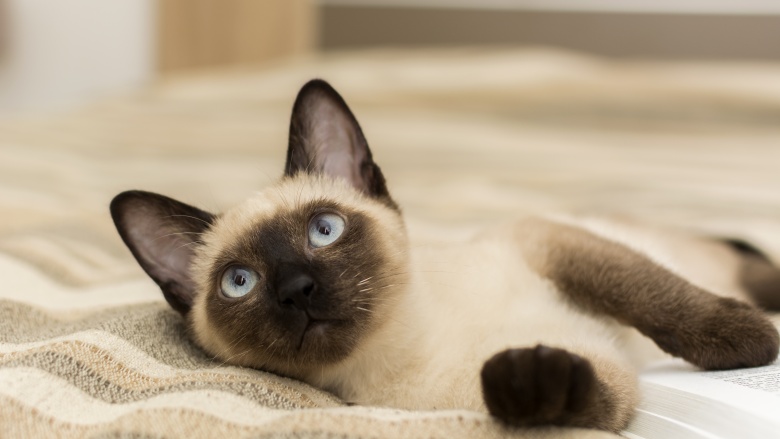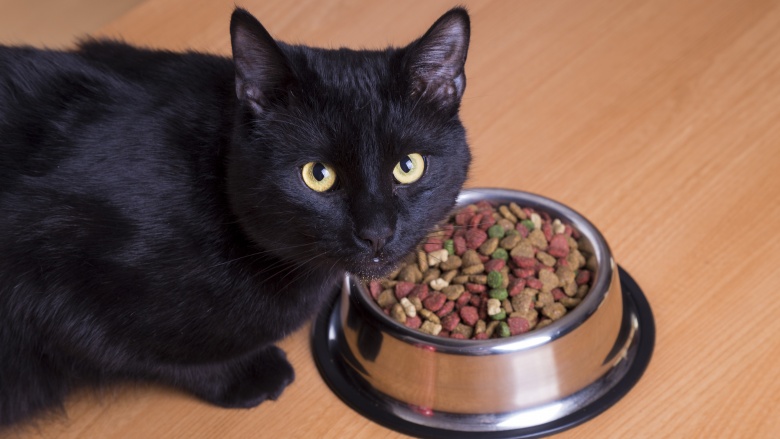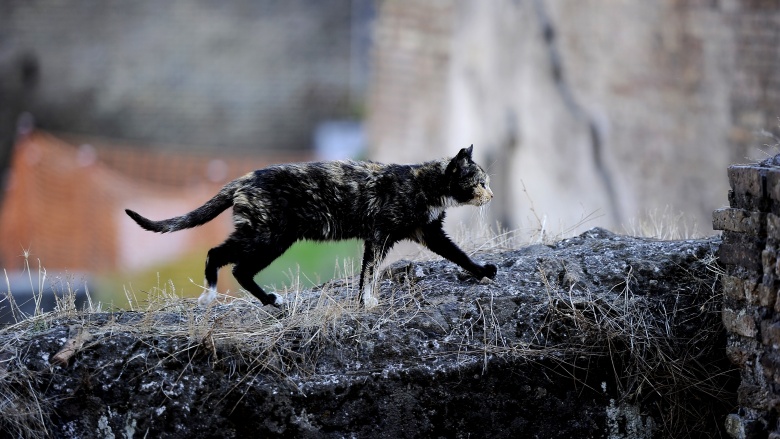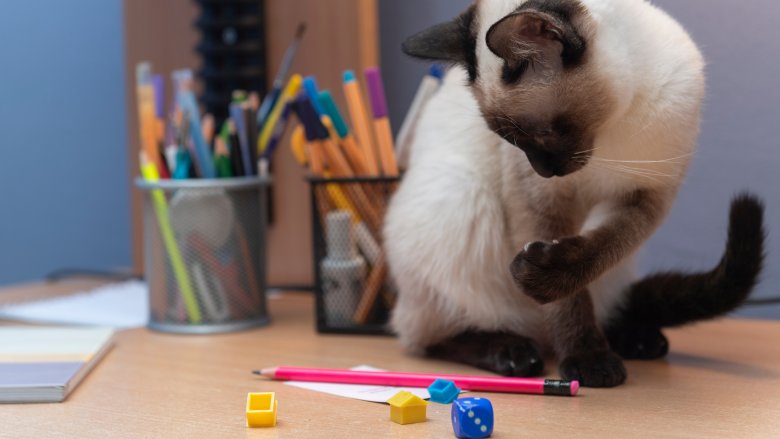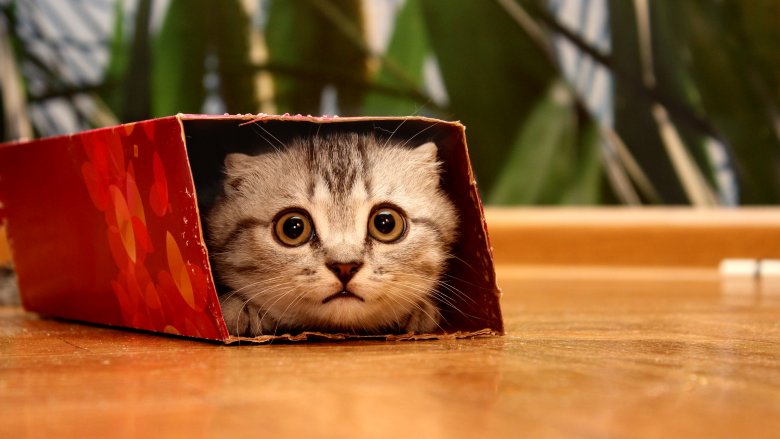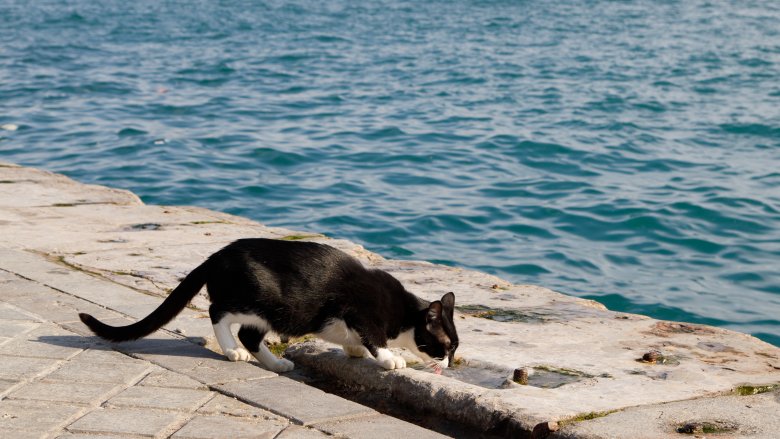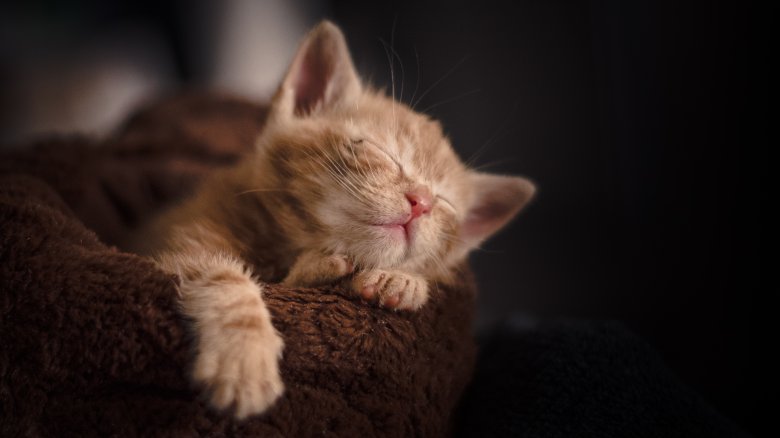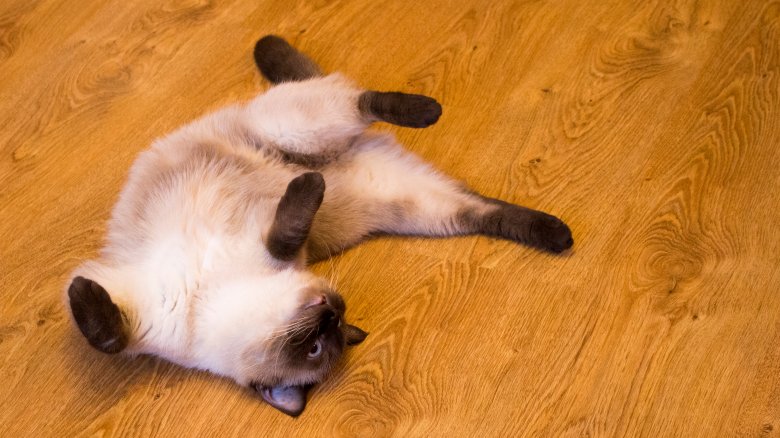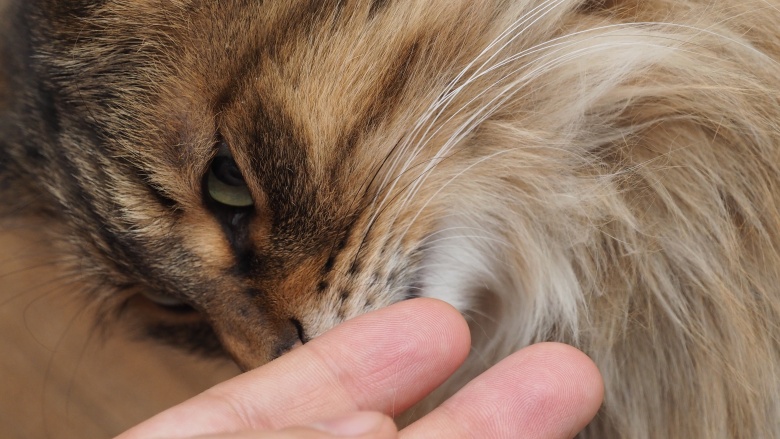The Real Reason Why Cats Purr And Other Feline Facts
Cats, as the old saying goes, were once worshiped as gods and have never allowed the world to forget it. And why not? They're adorable, and who cares if they show a little sociopathic behavior every so often? Cuteness will get you out of a lot, but their standoffish nature and refusal to participate in behavioral studies (like their canine counterparts often do) means that we know surprisingly little about what's going on inside a kitty's mind. We do think that there's quite a lot happening in there, though, because they're just fascinating little heart-stealers. Here's why cats purr, along with other fun feline facts.
They're not actually domesticated -- they just let us think they are
No one's sure when cats first moved into our homes and our hearts, but the most commonly repeated trivia tidbit is that it happened in ancient Egypt around 4,000 years ago. There's other evidence that suggests it happened well before that, with remains of a human and cat buried together dating back 9,500 years. Cats in China were keeping homes rat-and-mouse-free (and sharing leftovers) around 5,300 years ago, so no one's exactly sure when the mysterious cat showed up and volunteered their services, and we're pretty sure that's how they plan on keeping it.
By comparison, dogs have been at our sides for at least 15,000 years, and over those years we've selectively bred dogs to fill certain roles, from hunting and herding to sitting in purses. Cats, on the other hand? They're ... cats. Sure, there's breeds of cats, but they're more or less cat-shaped. There aren't cats that specialize in herding or mousing or ... well, to be fair, they're all specialists in being gods and goddesses.
When scientists took an up-close-and-personal look at their DNA, they found there's an incredibly good reason for this: they're pretty much not domesticated, at least, on a genetic level. Sure, there's the troll that says, "Clearly, they're domesticated, I'm not letting a filthy wild animal in my house." You'd be at least partially wrong, Troll. Genetically, our domestic housecat still has most of their DNA in common with their wild cousins, and unlike dogs (who have gotten rid of most of the unsavory behavior of wolves), cats have kept their wild instincts, too. Just ask anyone who's walked outside to enjoy a nice, warm spring day and stepped in disemboweled rodent.
Cats have almost mastered language for humans
We know you talk to your cat, and we know she talks back. (You don't? You're a heathen or a liar.) It turns out that language is another way cats display the brilliance they all know they possess, and we take for granted. Cats have a whole bunch of ways to communicate with us, and it's up to humans to pay enough attention to facial and body cues, like "crazy face" and "STFU ears," to be able to understand what they're saying.
They've also developed a super-top-secret language that adult cats only use to communicate with humans: meowing. While kittens meow at their mothers, adult cats that live together don't usually meow at each other, and studies of feral cat colonies find that adult cats in feline company are pretty quiet. It's only humans that they meow to and, if you pay any attention to your cat at all, you can probably tell what they're saying. Things like, "Put those opposable thumbs to good use and open the cat food now, Human!" might sound pretty different from something that means, "Please sit and give me cuddles, and I will allow you to bask in my sleepy, adorable glory."
In 2003, Cornell University researchers tested whether or not we could understand our cats or if we just take environmental cues to figure out what they're saying. They had people listen to recordings of cats and try to tell what they wanted. The listeners could, but only when the sounds were coming from their own cat. Okay, so there probably isn't some universal cat-language that they're teaching us. They are, however, each teaching us their own commands, which might be even more worrying? That's strictly a skill that's been developed by domestic cats, and we tend to interpret wild cats as sounding just angry, no matter what they're saying. The moral of the story is that your cat has learned how to sweet-talk you to get what he wants.
Your cat might have an allergy to humans
You know that guy: the one who claims that he can't have a cat or be near yours because he has an allergy. He says it like it's such a massive moral sacrifice too, right? It turns out that he might be the cause of allergies in cats, too, and if you ask us? That's a bigger offense.
It's estimated that about 1 to 5 percent of cats suffer from a cat version of asthma. It's a lot like human asthma, and essentially leads to breathing issues and coughing. The biggest cause? People. Human dandruff is cited as a major cause of feline asthma, along with other irritants that humans bring into their homes, like cigarette smoke. If you're a smoker and your cat coughs a lot, or sounds wheezy? Congratulations, you're suffocating him.
That's not an exaggeration, either. Some cats can have such a powerful allergic reaction to humans (and their disgusting habits), and they have to fight to breathe so much, they could suffer collapsed lungs or even broken ribs. Antibiotics and anti-inflammatories have been shown to help, and asthmatic cats can usually have their conditions managed, even though vets consider it incurable. So, be a decent human being and quit smoking.
Why some cats are catnip junkies
Do you ever feel like a crack dealer when your cat sees you getting out the catnip? For about 50% of the cat population, catnip is like happiness in herbal form, while the other half (and kittens) have no response to it whatsoever. What gives?
The gene that makes cats sensitive to catnip is hereditary, and it's an inherited response to a chemical called nepetalactone. The scent bonds to receptors in the cat's nasal passages, which then stimulate the sensory receptors in the brain. If your cat's acting like they're on a complete sensory overload, that's because they absolutely are. And they're loving it. Some cats have a ... specific set of responses they exhibit when they're exposed to catnip, and it's akin to a cat in heat. That's because the senses that are being overloaded are the same ones triggered by cat pheromones, so when you give your cat some of the nip? Give them some alone time, too. They deserve it, and expect it.
Their brains have 90% in common with ours
It's an age-old argument: who's smarter, cats or dogs? (People aren't a choice in the equation, because cats and dogs are both definitely smarter than most people.) It turns out that, on a biological level, cats might have a slight edge on dogs, but we hope you won't tell them that. Dogs will never live it down.
With the wonders of modern science, researchers have been able to measure the number of neurons present in the part of cat and dog brains responsible for things like problem-solving and information processing. A cat has a staggering 300 million neurons in the information-processing part of its brain, while a dog only has 160 million. Sorry, pups.
While that means that cats are going to be quicker at some things than dogs, what about comparing them to humans? Part of human's processing power comes from the folds that are on the surface of our brains. The more wrinkles there are, the larger the surface area and, in turn, the more processing power the brain has. That's where the 90% number comes in, and it turns out that cat brains are wrinkled like ours, so much so that they're 90% similar. They also have large and complex cerebral structures, which governs decision-making, memory, advance planning, and reasoning skills. Their similar brains mean that there's a lot going on in there, and if they found time and motivation to care, they could outsmart circles around Pupper. So the next time you suspect Kitty is plotting to install himself as the world's next great supervillain, he just might be.
Girls are right-handed, boys are left-handed
Right. Since we all need a little recovery time after realizing Snuggles probably wants to conquer the world, here's a fun bit of trivia that's made us realize we should have been scientists. Specifically, we should have been the kind of scientists that get this kind of funding. Psychologists at Queen's University Belfast in Northern Ireland asked themselves whether cats were right-pawed or left-pawed, and you've wondered it, too. We certainly have. They wanted to see which paw cats favored, so they gave 42 different cats a jar with a bit of tuna in it. The only way they could get it out was to reach in and, well, fish it out — when they did, they'd show which paw was dominant.
There were 21 males and 21 females in the test, and 20 of the males were left-handed, with one ambidextrous over-achiever. Twenty of the females were right-handed, and one girl, in true cat spirit, refused to conform to any human societal expectations.
Cats develop dementia like humans do
Cats might have nine lives, but they still, sadly, don't live as long as we do. They're living to older ages, though, and those advances in everything from health care to pet food have made us realize something completely heartbreaking. Not only do their brains look like ours, but they act and age like ours do, too. Cognitive dysfunction happens in a lot of older cats, and can typically start to set in around 10 years of age. The condition gets progressively worse, and the symptoms are similar to those seen in humans that have been diagnosed with Alzheimer's or dementia.
Signs vary, and include things like a lack of interest, long and random pauses of staring into space, disorientation, random wanderings, and loud meowing, especially talking when no one's around. As cats age, other problems, like arthritis and blindness, can add to the problems, confusion and disorientation that develops.
While there's not anything we can do to keep away the effects of aging (if only), there are a few things we can do to help. Antioxidants and vitamin E are thought to help at least slow the aging process, and environmental factors can make a big difference, too. Don't bring other animals (or other kinds of chaos) into the house, keep things in the same, familiar places, and make sure you keep accessibility in mind when it comes to things like stairs.
That one was pretty depressing, too, we know. It's absolutely the last sad one, we promise.
Some cats are heat-sensitive color-changers
We feel like we have to make it up to you for all the sadness and oh, have we ever, with just one incredibly awesome fact that'll make you forget all about senile cats forgetting who you are. What about the fact that some cats are heat-sensitive, and can change their color based on their environment? We know, right? You're welcome.
So, how the hey does that work? A helluva cool bit of science, that's how, and here's the short version. There are eight different sets of genes in each cat that governs what color they're going to be. Siamese cats (and their close cousins) have a gene modifier called a Siamese allele. That particular allele blocks color from getting to the cat's fur, which should, in theory, make them albinos. But it doesn't, because it's only activated by heat. Once the temperature gets up to around 100 degrees, the color stops. That's why the cooler parts of a Siamese cat's body (nose, ears, paws) are usually dark, while the rest of their fur stays light. That's also why they're born white. When they're still inside Mom, the temperature's obviously pretty warm and keeps their color gene from activating. It's only when they hit the cool air that they start to color.
We're not done yet. It doesn't just happen once — these cats can change color any time when the temperature of their environment changes. There's also two different forms of the Siamese allele, one that creates the incredibly dark, distinctive markings of a Siamese, and another that's found in Burmese and Tonkinese cats that does the same thing with a lesser effect. And you thought Siamese cats just looked awesome. They're all awesome in the most 1980s, color-change t-shirt way a cat can be.
Cats are picky eaters because of the way their taste buds work
So, you're in the grocery store, looking for something special for that someone special. A nice can of tuna? Salmon? Tuna's always a win ... and so is spaghetti sauce. Tuna in spaghetti sauce? Kitty will love it! You get home, open the can, put it nicely on the plate, paying close attention to your presentation ... and the cat turns up her nose. (What, just us?)
Cats are picky eaters, and even if you think you've got them figured out, they'll prove you wrong. That's not just out of spite — they're actually picky because of the way their taste buds work. Cats have always been carnivores, and wild, feral cats still rely on a heavily meat-based diet for their survival. Taste buds convey a huge amount of information, including when something's gone bad or been poisoned. And cats have two different receptors in their tongues that taste bitterness, likely developed to help them pick up on bitterness in a way that's completely different from how we taste things.
Scientists still aren't sure just how cats interpret bitterness, but it's likely that they're more sensitive to certain types of compounds. Some experiments found that cats had absolutely no response to saccharin and were only slightly sensitive to aloin, but were incredibly sensitive to a thing called denatonium. Doesn't sound familiar? It's an additive that's put in chemicals that are potentially deadly, and it's designed specifically to keep pets and kids from eating things that they shouldn't. How cats interpret other kinds of flavors is still unclear, but we're still pretty sure they know what's best.
How far do cats travel?
Cats have just a bit of a reputation for being insufferably lazy, and they are. Most of the time. But if you've ever known an outdoor cat, you'll know they also have a tendency to disappear for a good long while whenever they feel like it. So, what gives?
The University of Illinois headed up a two-year research study that fit 42 cats with radio trackers that monitored their every move. That was literal with some, as 23 of them were fitted with trackers that included vibration sensors that gave a glimpse not just into where they were, but what they were doing. The cats were a mix of ferals and free-roaming cats that did, technically, have a home.
The cat with the biggest patch of kingdom was a male feral who wasn't named in the study, but who we'll call Stewie because why not. Stewie's "home territory" covered a whooping 1,351 acres that included everything from city streets and a college campus to fields. As far as researchers could tell, no one made an active effort to feed Stewie, and he was left to his own devices to not just find food, but navigate his way through busy city streets and rural areas with dangers like coyotes. He even seemed to know what stoplights meant, using them to cross streets before bedding down at wherever was convenient for the night. Holy crap, Stewie, we know people who couldn't do that.
Stewie was a special case, but even cats that technically had homes wandered about 4.9 acres over the course of the study. All the cats favored being close to buildings, and surprisingly, the study also found that housecats allowed to roam had a greater impact on local wildlife than ferals, who relied on hunting for survival. The moral of the story? Don't be hating on Stewie.
Stop throwing things off the table!
It might be the reason numerous cats think their name starts with an expletive of some sort, and it's that seemingly uncontrollable desire to push things off tables and counters and onto the floor. According to Dr. Wailani Sung (via VetStreet), there are actually a whole bunch of reasons Fluffy might love to do this.
Sometimes, it's likely an accident. Cats use their paws like hands, and they may just be checking out a new thing. They poke it, push it ... and they they push it just a little too far. But that's when it the game gets fun.
Cats love fast movement, and everyone knows how fast a coffee cup falls when it's been knocked off the table by exploring paws. Fluffy might seem like a spoiled little princess, but she's really still a hunter by nature. And according to the experts interviewed by Inverse, sending something flying with a swipe of a paw is one way they turn something boring into a bit of excitement reminiscent of a scurrying mouse.
Then, there's another factor: It gets Mom and Dad's attention, doesn't it? And that's probably part of it. Fluffy might find it's a brilliant, foolproof way to suddenly be in the center of all the action. Fortunately, it's also a behavior that frustrated owners can stop — get Fluffy more toys, play with her more often, and redirect her into more useful pastimes, like keeping the dog in line.
If I fits, I sits!
If there's one thing cats have in common with toddlers, it's their obsession with boxes. Even big cats love boxes, and while it's impossible to tell exactly what's going on in all those feline brains, Wired has some suggestions.
A box provides cats with a place to hide and potentially ambush passing ankles, and the security of being in an enclosed space. When researchers in the Netherlands measured the stress levels in cats and studied the benefits of giving them boxes to hide in, they found the cats with boxes adjusted much more easily to new surroundings and weren't nearly as stressed as cats who weren't given boxes.
Essentially, it's a way of resolving conflict. It's much more efficient for them to hide from their problems (like a visiting grabby toddler) than it is to fight. Boxes are safe spaces free from sticky hands.
But it's not all about stress. What about a cat's tendency to sit in other weird places, like the bathroom sink or in bowls? There's actually a physical explanation for that. Cats have a comfortable temperature range of between 86 and 97 degrees Fahrenheit, much warmer than mere humans prefer. That means cats tend to seek out not just the sunny spots on the floor, but confined spaces that will be warmer than the open air. It'll help them conserve body heat and energy, and that means when your cat gets stuck in a flower vase, they're actually just being super efficient.
Why cats can drink seawater but not ... milk
It's one of the oldest images of cats: lapping milk from a saucer. Sure, those little dribbles of milk on their chins are adorable, but according to the Prestige Animal Hospital, there's a huge problem. Most cats are actually lactose intolerant, and giving Princess Lady a saucer of milk is also giving her major stomach cramps, vomiting, diarrhea, and a ton of discomfort. Cats — like humans and other mammals — are born with the ability to digest lactose, but that ability disappears after they're no longer nursing from Mama. That's why the cat milk sold in stores is lactose-free.
And here's the really weird thing. While cats can't comfortably digest milk, they can drink something else — seawater. Their kidneys are actually so efficient they can easily process the salt out of seawater, and it's perfectly fine for them.
And here's a little footnote from Cattime: Cats (and dogs) actually have taste receptors on their tongues that give water a flavor. That stuff's delicious to them!
Why do they have so many sleeping places?
Cats don't just sleep a lot — they sleep all over the place. You might find Captain Fuzzy-Butt in a window, in a chair upstairs, in a different chair upstairs, in your bed, and so on. Why do they feel the need to switch it up?
According to experts at Catster, part of the reason is likely seasonal. The windowsill Fuzzy-Butt loves in the summertime isn't as nice in the winter months, so he goes elsewhere until the long, sunny afternoons come back.
Others say (via Petful) part of it is likely instinctual. Wild cats tend to sleep in different places for safety, varying their routine to help make sure they aren't easy targets. When there's more than one cat in the house, it's likely a territorial thing, too. Since cats like to be up high, the highest perch in the cat tree is the domain of the dominant or oldest cat. Sometimes they share, sometimes not so much.
And sometimes, Senior Cat Wellness adds, it might be about the humans. Sleeping with a human is a way of bonding, and they might just want to bond with everyone a little bit. It's also possible they decide to move because of changes in the mood or family dynamic, whether human or cat. Anything from chaos in the household to grief over the loss of a friend (and yes, cats feel grief) might make them withdraw from old, favorite places. Cats are complicated.
Why do cats lie on their backs to say hello?
You come home from a long day at work, and your cat ... well, she doesn't come running, but she does wait patiently in the hall for you. You lean over to pet her, and flop. If you think she's sending you a message, you're right — and no, it's not that she's just trying to make you reach even farther to give her pets and scritches.
According to Canidae, that belly-exposing back stretch is an awesome message to get because it means your little floof is super glad to see you. The Nest says it can be even more than a welcome home. By showing off her most vulnerable bits and putting herself in that most vulnerable position, she's showing that she's happy, relaxed, and that she feels completely and totally safe.
While it's usually dogs that have the reputation for liking belly rubs, some cats like them, too. Flipping over on her back might also be an invitation ("Pet Me Here!") if your cat is that sort of cat. Either way, that gesture is just for you, and it's the same thought process and expression of trust that's behind a cat sleeping on her back, says Senior Cat Wellness. She's warm, safe, and you make her one happy cat. Think cats don't give compliments? Maybe it's just that most people don't know how to read them.
So why do cats purr?
We're sorry. We said there would be no dark facts anymore, but we lied. This here might be the darkest of them all, and we apologize in advance.
First, the happy. Even the most marginal of cat people know that cats purr when they're happy. They make the noise by some sort of respiratory magic that happens in their diaphragm and larynx, and just how they do it remains one of the best mysteries of modern science. (It's one that we think we need a grant to be able to study in-depth.) It turns out that the idea of purring at happiness might be a bit of a misunderstanding, and they're actually asking us to keep petting them or keep providing a comfortable lap for them to sleep on. It's more like a polite and dignified request.
Now, the not-so-happy. Cats also purr when they're injured or scared, and researchers think that it has something to do with the healing power of the purr. You absolutely read that right. Cats purr at a frequency of 26 hertz (for most domestic cats), and that just happens to be the same frequency that's been found to promote healing in bone and other body tissues. Crazy, right? But that's the deal, and when cats are injured, they're likely trying to help themselves heal or comfort themselves by the reverberation of their own purr. It's why cats will often curl up with an injured cat (or non-cat) and purr. They're trying to help.
And now, the even worse part. Since cats purr to comfort themselves, it's also something that dying cats have been observed doing. They do it to console themselves and maybe, just maybe, to console you a little bit. Go on, wipe away that tear. That's what we need to do.

